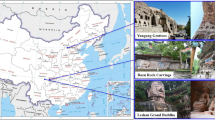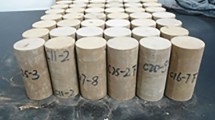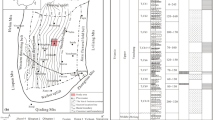Abstract
Porous stone that has been exposed to the natural environment for a long time has developed a variety of diseases under the influence of environmental and geological factors. Especially, migration of soluble salt solution in porous stone and salt crystallization will inevitably lead to the deterioration of stone surface. To investigate the spatial and temporal evolution features of porous stone during capillary water migration, a series of capillary water absorption tests with different types of porous sandstone were performed. The process of capillary water absorption and stone surface deterioration characteristics was observed by high-density resistivity method. The results indicate that the process of capillary rise can be divided into stages of rapid rising, transition, and slow rising. According to the analysis of electrical resistivity measurements at millimeter scale, there was a negative correlation between capillary rise rate and sample total porosity, and the rising trend of the dry–wet interface was presented as the saddle shape. Then, a novel capillary rise model was proposed considering the variation in pore saturation. Moreover, it has been demonstrated that the migration and crystallization of soluble salt solution were the main causes for the change of micropore structure, resulting in increased deterioration of porous stone during the dry–wet cycles. This present study serves as some references for the protection and restoration of porous stone.
















Similar content being viewed by others
References
Allam H, Duplan F, Clerc JP, Amziane S, Burtschell Y (2020) About electrical resistivity variation during drying and improvement of the sensing behavior of carbon fiber-reinforced smart concrete. Constr Build Mater 264:120699. https://doi.org/10.1016/j.conbuildmat.2020.120699
Alves C, Figueiredo CAM, Sanjurjo-Sánchez J, Hernández AC (2021) Salt weathering of natural stone: a review of comparative laboratory studies. Heritage 4:1554–1565. https://doi.org/10.3390/heritage4030086
An N, Tang CS, Cheng Q, Wang DY, Shi B (2020) An experimental application of electrical resistivity/resistance method (ERM) to characterize the evaporation process of sandy soil. Phys Chem Earth, Parts a/b/c 117:102873. https://doi.org/10.1016/j.pce.2020.102873
Archie GE (1942) The electrical resistivity log as an aid in determining some reservoir characteristics. Trans Am Inst Min Metall Eng 5:1–8
Bai B, Rao DY, Chang T, Guo ZG (2019) A nonlinear attachment-detachment model with adsorption hysteresis for suspension-colloidal transport in porous media. J Hydrol 578:124080. https://doi.org/10.1016/j.jhydrol.2019.124080
Barone G, Mazzoleni P, Pappalardo G, Raneri S (2015) Microtextural and microstructural influence on the changes of physical and mechanical proprieties related to salts crystallization weathering in natural building stones. The example of Sabucina stone (Sicily). Constr Build Mater 95:355–365. https://doi.org/10.1016/j.conbuildmat.2015.07.131
Basu S, Orr SA, Aktas YD (2020) A geological perspective on climate change and building stone deterioration in London: Implications for urban stone-built heritage research and management. Atmosphere (basel) 11(8):788. https://doi.org/10.3390/ATMOS11080788
Cai JC, ** TX, Kou JS, Zou SM, **ao JF, Meng QB (2021) Lucas-Washburn equation-based modeling of capillary-driven flow in porous systems. Langmuir 37:1623–1636. https://doi.org/10.1021/acs.langmuir.0c03134
Çelik MY, Sert M (2021) An assessment of capillary water absorption changes related to the different salt solutions and their concentrations ratios in the Döğer tuff (Afyonkarahisar-Turkey) used as building stone of cultural heritages. J Build Eng 35:102102. https://doi.org/10.1016/j.jobe.2020.102102
Chen GB, Li Y, Li T, Zhang GH (2022) Deterioration law of intermittent jointed sandstone mechanical properties under water–rock interaction. Acta Geophys 70(4):1923–1935. https://doi.org/10.1007/s11600-022-00832-5
Fang JC, Deng HF, Qi Y, **ao Y, Zhang HB, Li JL (2019) Analysis of changes in the micromorphology of sandstone joint surface under dry-wet cycling. Adv Mater Sci Eng 2019:8758203. https://doi.org/10.1155/2019/8758203
Fediuk A, Wilken D, Thorwart M, Wunderlich T, Erkul E, Rabbel W (2020) The applicability of an inverse schlumberger array for near-surface targets in shallow water environments. Remote Sens 12(13):2132. https://doi.org/10.3390/rs12132132
Folk RL (1974) Petrology of sedimentary rocks. Hemphill Publishing Co., Austin, Texas, p 182
Gibeaux S, Vazquez P, De Kock T, Cnudde V, Thomachot-Schneider C (2018) Weathering assessment under X-ray tomography of building stones exposed to acid atmospheres at current pollution rate. Constr Build Mater 168:187–198. https://doi.org/10.1016/j.conbuildmat.2018.02.120
Han TC, Best AI, Sothcott J, North LJ, MacGregor LM (2015) Relationships among low frequency (2 Hz) electrical resistivity, porosity, clay content and permeability in reservoir sandstones. J Appl Geophys 112:279–289. https://doi.org/10.1016/j.jappgeo.2014.12.006
Hatir ME (2020) Determining the weathering classification of stone cultural heritage via the analytic hierarchy process and fuzzy inference system. J Cult Herit 44:120–134. https://doi.org/10.1016/j.culher.2020.02.011
Hou DS, Zhang W, Sun M, Wang P, Wang MH, Zhang JR, Li ZJ (2020) Modified Lucas-Washburn function of capillary transport in the calcium silicate hydrate gel pore: a coarse-grained molecular dynamics study. Cem Concr Res 136:106166. https://doi.org/10.1016/j.cemconres.2020.106166
Hsu SY, Huang V, Park SW, Hilpert M (2017) Water infiltration into prewetted porous media: dynamic capillary pressure and green-Ampt modeling. Adv Water Resour 106:60–67. https://doi.org/10.1016/j.advwatres.2017.02.017
Huang Z, Zeng W, Gu QX, Wu Y, Zhong W, Zhao K (2021) Investigations of variations in physical and mechanical properties of granite, sandstone, and marble after temperature and acid solution treatments. Constr Build Mater 307:124943. https://doi.org/10.1016/j.conbuildmat.2021.124943
Huang X, Pang JX, Zou JQ (2022) Study on the effect of dry–wet cycles on dynamic mechanical properties of sandstone under sulfuric acid solution. Rock Mech Rock Eng 55:1253–1269. https://doi.org/10.1007/s00603-021-02729-z
Jia M, Liang J, He L, Zhao X, Simon S (2019) Hydrophobic and hydrophilic SiO2-based hybrids in the protection of sandstone for anti-salt damage. J Cult Herit 40:80–91. https://doi.org/10.1016/j.culher.2019.06.001
Jiang G, Guo F, Polk JS (2015) Salt transport and weathering processes in a sandstone cultural relic, North China. Carbonates Evaporites 30:69–76. https://doi.org/10.1007/s13146-014-0202-9
** JX, Zhang XL, Liu XL, Li YH, Li SH (2023) Study on critical slowdown characteristics and early warning model of damage evolution of sandstone under freeze–thaw cycles. Front Earth Sci 10:1006642. https://doi.org/10.3389/feart.2022.1006642
Jo YH, Lee CH (2022) Ultrasonic properties of a stone architectural heritage and weathering evaluations based on provenance site. Appl Sci 12(3):1498. https://doi.org/10.3390/app12031498
Junique T, Vazquez P, Geraud Y, Thomachot-Schneider C, Sidibe H (2021) Microstructural evolution of granitic stones exposed to different thermal regimes analysed by infrared thermography. Eng Geol 286:106057. https://doi.org/10.1016/j.enggeo.2021.106057
Lago M, Araujo M (2001) Capillary rise in porous media. Phys A Stat Mech Its Appl 289:1–17. https://doi.org/10.1016/S0378-4371(00)00460-X
Li M, Yu HM, Du HP (2020) Prediction of capillary suction in porous media based on micro-CT technology and B-C model. Open Phys 18(1):906–915. https://doi.org/10.1515/phys-2020-0203
Liang K, Zeng XH, Zhou XJ, Ling CB, Wang P, Li KP, Ya SS (2018) Investigation of the capillary rise in cement-based materials by using electrical resistivity measurement. Constr Build Mater 173:811–819. https://doi.org/10.1016/j.conbuildmat.2018.02.155
Lindström N, Heitmann N, Linnow K, Steiger M (2015) Crystallization behavior of NaNO3-Na2SO4 salt mixtures in sandstone and comparison to single salt behavior. Appl Geochem 63:116–132. https://doi.org/10.1016/j.apgeochem.2015.07.007
Liu BL, Yang HQ, Karekal S (2020) Effect of water content on argillization of mudstone during the tunnelling process. Rock Mech Rock Eng 53:799–813. https://doi.org/10.1007/s00603-019-01947-w
Liu Y, Zhang ZL, Liu X, Wang L, **a XH (2021) Efficient image segmentation based on deep learning for mineral image classification. Adv Powder Technol 32:3885–3903. https://doi.org/10.1016/j.apt.2021.08.038
Lockington DA, Parlange JY (2004) A new equation for macroscopic description of capillary rise in porous media. J Colloid Interface Sci 278:404–409. https://doi.org/10.1016/j.jcis.2004.06.024
Ludovico-Marques M, Chastre C (2012) Effect of salt crystallization ageing on the compressive behavior of sandstone blocks in historical buildings. Eng Fail Anal 26:247–257. https://doi.org/10.1016/j.engfailanal.2012.08.001
Ma TT, Wei CF, Yao CQ, Yi PP (2020) Microstructural evolution of expansive clay during drying–wetting cycle. Acta Geotech 15(8):2355–2366. https://doi.org/10.1007/s11440-020-00938-4
Mareš J, Bruthans J, Weiss T, Filippi M (2022) Coastal honeycombs (Tuscany, Italy): moisture distribution, evaporation rate, tensile strength, and origin. Earth Surf Process Landforms 47(6):1653–1667. https://doi.org/10.1002/esp.5340
Mehrabian H, Gao P, Feng JJ (2011) Wicking flow through microchannels. Phys Fluids 23(8):122108. https://doi.org/10.1063/1.3671739
Menéndez B, Petranova V (2016) Effect of mixed vs single brine composition on salt weathering in porous carbonate building stones for different environmental conditions. Eng Geol 210:124–139. https://doi.org/10.1016/j.enggeo.2016.06.011
Mol L, Viles HA (2012) Exposing drying patterns: using electrical resistivity tomography to monitor capillary rise in sandstone under varying drying conditions. Environ Earth Sci 68(6):1647–1659. https://doi.org/10.1007/s12665-012-1858-x
Molina E, Benavente D, Sebastian E, Cultrone G (2015) The influence of rock fabric in the durability of two sandstones used in the Andalusian Architectural Heritage (Montoro and Ronda, Spain). Eng Geol 197:67–81. https://doi.org/10.1016/j.enggeo.2015.08.009
Mosavinejad SHG, Barandoust J, Ghanizadeh A, Sigari M (2018) Crack detection of a HPCFRCC thin plate using electrical resistivity method. Constr Build Mater 193:255–267. https://doi.org/10.1016/j.conbuildmat.2018.10.190
Mutschler T, Kramar U, Vergara MR, Triantafyllidis T (2013) Influence of hematite coating on the activation of the swelling potential of smectite-bearing rocks. Rock Mech Rock Eng 46:835–847. https://doi.org/10.1007/s00603-012-0289-z
Nara Y, Morimoto K, Yoneda T, Hiroyoshi N, Kaneko K (2011) Effects of humidity and temperature on subcritical crack growth in sandstone. Int J Solids Struct 48(7–8):1130–1140. https://doi.org/10.1016/j.ijsolstr.2010.12.019
Pan BZ, Ruhan A, Guo YH, Zhang LH, Wei BY, Zhou WY (2022) An experimental study on the complex resistivity of fractured rock under different saturation conditions. Acta Geophys 70(3):1061–1081. https://doi.org/10.1007/s11600-022-00762-2
Pandey SC, Pollard AM, Viles HA, Tellam JH (2014) Influence of ion exchange processes on salt transport and distribution in historic sandstone buildings. Appl Geochem 48:176–183. https://doi.org/10.1016/j.apgeochem.2014.07.001
Pedrosa F, Andrade C (2021) Spatial variability of concrete electrical resistivity and corrosion rate in laboratory conditions. Constr Build Mater 306:124777. https://doi.org/10.1016/j.conbuildmat.2021.124777
Peng J, Xu CH, Dai BB, Sun LJ, Feng JJ, Huang QS (2022) Numerical investigation of brittleness effect on strength and microcracking behavior of crystalline rock. Int J Geomech 22(10):04022178. https://doi.org/10.1061/(asce)gm.1943-5622.0002529
Pötzl C, Dohrmann R, Siegesmund S (2018) Clay swelling mechanism in tuff stones: an example of the Hilbersdorf Tuff from Chemnitz. Germany Environ Earth Sci 77(5):118. https://doi.org/10.1007/s12665-018-7345-2
Qi BW, Xu PL, Wu CZ (2023) Analysis of the infiltration and water storage performance of recycled brick mix aggregates in sponge city construction. Water 15(2):363. https://doi.org/10.3390/w15020363
Qu ML, Lu SY, Lin QY, Foroughi S, Yu ZT, Blunt M (2022) Characterization of water transport in porous building materials based on an analytical spontaneous imbibition model. Transp Porous Media 143(2):417–432. https://doi.org/10.1007/s11242-022-01776-6
Rastegarnia A, Ghafoorri M, Moghaddas NH, Lashkaripour GR, Shojaei H (2022) Application of cuttings to estimate the static characteristics of the dolomudstone rocks. Geomech Eng. 29(1):65–77. https://doi.org/10.12989/gae.2022.29.1.065
Ren CH, Yu J, Liu SY, Yao W, Zhu YL, Liu XY (2022) A plastic strain-induced damage model of porous rock suitable for different stress paths. Rock Mech Rock Eng 55:1887–1906. https://doi.org/10.1007/s00603-022-02775-1
Sadjadi Z, Jung M, Seemann R, Rieger H (2015) Meniscus arrest during capillary rise in asymmetric microfluidic pore junctions. Langmuir 31(8):2600–2608. https://doi.org/10.1021/la504149r
Sato M, Hattanji T (2018) A laboratory experiment on salt weathering by humidity change: salt damage induced by deliquescence and hydration. Prog Earth Planet Sci 5:84. https://doi.org/10.1186/s40645-018-0241-2
Scherer GW (2004) Stress from crystallization of salt. Cem Concr Res 34:1613–1624. https://doi.org/10.1016/j.cemconres.2003.12.034
Selim H, Karakaş A, Coruk Ö (2019) Investigation of engineering properties for usability of Lefke stone (Osmaneli/Bilecik) as building stone. Bull Eng Geol Environ 78(8):6047–6059. https://doi.org/10.1007/s10064-019-01520-3
Soomro A, Qureshi AL, Jamali MA, Ashraf A (2019) Groundwater investigation through vertical electrical sounding at hilly area from Nooriabad toward Karachi. Acta Geophys 67(1):247–261. https://doi.org/10.1007/s11600-019-00247-9
Sousa L, Siegesmund S, Wedekind W (2018) Salt weathering in granitoids: an overview on the controlling factors. Environ Earth Sci 77(13):502. https://doi.org/10.1007/s12665-018-7669-y
Supandi S (2021) Geotechnical profiling of a surface mine waste dump using 2D Wenner-Schlumberger configuration. Open Geosci 13:335–344. https://doi.org/10.1515/geo-2020-0234
Terzaghi K (1943) Theoretical soil mechanics
Useviciute L, Baltrenaite-Gediene E (2022) Modelling of a capillary rise height of biochar by modified Lucas-Washburn equation. Environ Model Assess 27(1):29–43. https://doi.org/10.1007/s10666-021-09782-6
Van Genuchten MT (1980) A closed-form equation for predicting the ing the hydraulic conductivity of unsaturated soils. Soil Sci Soc Am J 44(5):892–898. https://doi.org/10.2136/sssaj1980.03615995004400050002x
Van Belleghem B, Montoya R, Dewanckele J, Van den Steen N, De Graeve I, Deconinck J, Cnudde V, Van Tittelboom K, De Belie N (2016) Capillary water absorption in cracked and uncracked mortar–A comparison between experimental study and finite element analysis. Constr Build Mater 110:154–162. https://doi.org/10.1016/j.conbuildmat.2016.02.027
Villagrán-Zaccardi Y, Alderete N, De Belie N (2017) Improved model for capillary absorption in cementitious materials: progress over the fourth root of time. Cem Concr Res 100:153–165. https://doi.org/10.1016/j.cemconres.2017.07.003
Wang ZD, Zeng Q, Wang L, Yao Y, Li KF (2015) Electrical resistivity of cement pastes undergoing cyclic freeze-thaw action. J Mater Civ Eng 27(1):04014109. https://doi.org/10.1061/(ASCE)MT.1943-5533.0001042
Wang YH, Viles H, Desarnaud J, Yang SL, Guo QL (2021) Laboratory simulation of salt weathering under moderate ageing conditions: implications for the deterioration of sandstone heritage in temperate climates. Earth Surf Process Landforms 46(5):1055–1066. https://doi.org/10.1002/esp.5086
Wedekind W, López-Doncel R, Dohrmann R, Kocher M, Siegesmund S (2013) Weathering of volcanic tuff rocks caused by moisture expansion. Environ Earth Sci 69(4):1203–1224. https://doi.org/10.1007/s12665-012-2158-1
**ao D, Hu YF, Wang YY, Deng H, Zhang JC, Tang B, ** JY, Tang SH, Li G (2022) Wellbore cooling and heat energy utilization method for deep shale gas horizontal well drilling. Appl Therm Eng 213:118684. https://doi.org/10.1016/j.applthermaleng.2022.118684
Xu J, Lan W, Ren C, Zhou XG, Wang SH, Yuan J (2021) Modeling of coupled transfer of water, heat and solute in saline loess considering sodium sulfate crystallization. Cold Reg Sci Technol 189:103335. https://doi.org/10.1016/j.coldregions.2021.103335
Yang XR, Jiang AN, Li MX (2019) Experimental investigation of the time-dependent behavior of quartz sandstone and quartzite under the combined effects of chemical erosion and freeze–thaw cycles. Cold Reg Sci Technol 161:51–62. https://doi.org/10.1016/j.coldregions.2019.03.008
Yim HJ, Bae YH, Jun Y (2021) Hydration and microstructural characterization of early-age cement paste with ultrasonic wave velocity and electrical resistivity measurements. Constr Build Mater 303:124508. https://doi.org/10.1016/j.conbuildmat.2021.124508
Yuan GH, Cao YC, Jia ZZ, Gluyas J, Yang T, Wang YZ, ** KL (2015) Selective dissolution of feldspars in the presence of carbonates: the way to generate secondary pores in buried sandstones by organic CO2. Mar Pet Geol 60:105–119. https://doi.org/10.1016/j.marpetgeo.2014.11.001
Zeng XH, Liu HC, Zhu HS, Ling CB, Liang K, Umar HA, **e YJ, Long GC, Ma C (2020) Study on damage of concrete under uniaxial compression based on electrical resistivity method. Constr Build Mater 254:119270. https://doi.org/10.1016/j.conbuildmat.2020.119270
Zhang JK, Huang JP, Liu JH, Jiang SW, Li L, Shao MS (2019) Surface weathering characteristics and degree of Niche of Sakyamuni entering Nirvana at Dazu rock carvings. China Bull Eng Geol Environ 78(6):3891–3899. https://doi.org/10.1007/s10064-018-1424-1
Zhang ZZ, Niu YX, Shang XJ, Ye P, Zhou R, Gao F (2021d) Deterioration of physical and mechanical properties of rocks by cyclic drying and wetting. Geofluids 2021:6661107. https://doi.org/10.1155/2021/6661107
Zhang P, Chen ZL, Brown KG, Meeussen JCL, Gruber C, Garrabrants AC, Kosson DS (2021a) Drying model of a high salt content cementitious waste form: effect of capillary forces and salt solution. Cem Concr Res 146:106459. https://doi.org/10.1016/j.cemconres.2021.106459
Zhang XY, Ma FN, Yin SX, Wallace CD, Soltanian MR, Dai ZX, Ritzi RW, Ma ZQ, Zhan CJ, Lü XS (2021b) Application of upscaling methods for fluid flow and mass transport in multi-scale heterogeneous media: a critical review. Appl Energy 303:117603. https://doi.org/10.1016/j.apenergy.2021.117603
Zhang Z, Liu LL, Li C, Cai JC, Ning FL, Meng QG, Liu CL (2021c) Fractal analyses on saturation exponent in Archie’s law for electrical properties of hydrate-bearing porous media. J Pet Sci Eng 196:107642. https://doi.org/10.1016/j.petrol.2020.107642
Zhao HT, Ding J, Huang YY, Tang YM, Xu W, Huang DH (2019) Experimental analysis on the relationship between pore structure and capillary water absorption characteristics of cement-based materials. Struct Concr 20(5):1750–1762. https://doi.org/10.1002/suco.201900184
Zhao JH, Liu CL, Li CF, Zhang YC, Bu QT, Wu NY, Liu Y, Chen Q (2022) Pore-scale investigation of the electrical property and saturation exponent of Archie’s law in hydrate-bearing sediments. J Mar Sci Eng 10(1):111. https://doi.org/10.3390/jmse10010111
Zheng H, Feng XT, Pan PZ (2015) Experimental investigation of sandstone properties under CO2–NaCl solution-rock interactions. Int J Greenh Gas Control 37:451–470. https://doi.org/10.1016/j.ijggc.2015.04.005
Acknowledgements
This research is supported by the National Natural Science Foundation of China (No. 52179096) and the Natural Science Foundation of Chongqing (No. cstc2021jcyj-msxmX0903).
Author information
Authors and Affiliations
Corresponding author
Ethics declarations
Conflict of interest
The authors declare that they have no known competing financial interests or personal relationships that could have appeared to influence the work reported in this paper.
Additional information
Edited by Prof. Bogdan Mihai Niculescu (ASSOCIATE EDITOR) / Prof. Gabriela Fernández Viejo (CO-EDITOR-IN-CHIEF).
Rights and permissions
Springer Nature or its licensor (e.g. a society or other partner) holds exclusive rights to this article under a publishing agreement with the author(s) or other rightsholder(s); author self-archiving of the accepted manuscript version of this article is solely governed by the terms of such publishing agreement and applicable law.
About this article
Cite this article
Yang, H., Chen, C., Zhao, G. et al. Electrical resistivity analysis for the internal capillary water migration mechanism of porous stone. Acta Geophys. 72, 213–231 (2024). https://doi.org/10.1007/s11600-023-01081-w
Received:
Accepted:
Published:
Issue Date:
DOI: https://doi.org/10.1007/s11600-023-01081-w




